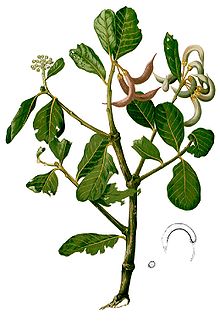| Aegiceras | |
|---|---|

| |
| Aegiceras corniculatum | |
| Scientific classification | |
| Kingdom: | Plantae |
| Clade: | Tracheophytes |
| Clade: | Angiosperms |
| Clade: | Eudicots |
| Clade: | Asterids |
| Order: | Ericales |
| Family: | Primulaceae |
| Subfamily: | Myrsinoideae |
| Genus: | Aegiceras Gaertn. |
| Species | |
|
See text | |
Aegiceras is a genus of trees and shrubs from Southeast Asia, Malesia, Australia and the Pacific Island,. and in Australia, in the Northern Territory, Queensland, New South Wales, and Western Australia. They occur as mangroves in coastal or estuarine areas.
The genus was first described in 1788 by Joseph Gaertner. The genus name, Aegiceras, derives from two Greek words: aix ("goat") and keras ("horn", and describes the genus as having fruits with horns like a goat.
Species
There are two species accepted by Plants of the World online.
- Aegiceras corniculatum (L.) Blanco
- Aegiceras floridum Roem. & Schult.
References
- ^ "Aegiceras Gaertn. | Plants of the World Online | Kew Science". Plants of the World Online. Retrieved 28 May 2021.
- ^ Harden, G.J. (1990). "PlantNET - FloraOnline; Aegiceras". plantnet.rbgsyd.nsw.gov.au. Retrieved 28 May 2021.
- "Aegiceras". Australian Plant Name Index, IBIS database. Centre for Plant Biodiversity Research, Australian Government.
- Sturm, J. G.; Gaertner, Joseph, 1732-1791 (1788), De fructibus et seminibus plantarum /Joseph Gaertner (in Latin), vol. 1, Sumtibus Auctoris, Typis Academiae Carolinae, pp. 216, t. 46, fig. 1, doi:10.5962/BHL.TITLE.53838, OCLC 17682598, Wikidata Q51462289
{{citation}}: CS1 maint: multiple names: authors list (link) CS1 maint: numeric names: authors list (link) - Glenn Wightman (2006). "Mangroves of the Northern Territory, Australia Identification and Traditional Use". Northern Territory Botanical Bulletin. 31: 44. Wikidata Q107006058.
| Taxon identifiers | |
|---|---|
| Aegiceras |
|
This Primulaceae article is a stub. You can help Misplaced Pages by expanding it. |